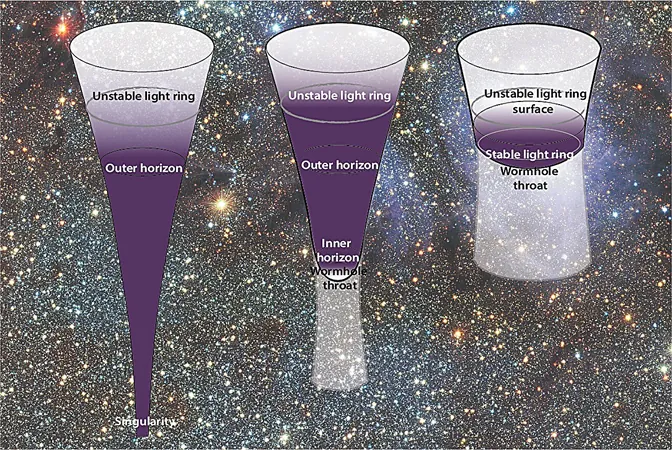
Revolutionary Black Hole Models Challenge the Notion of Singularities!
2025-05-06
Author: Wei
Rethinking Black Holes: A Bold New Perspective
For decades, black holes have fascinated and perplexed scientists, primarily due to their enigmatic centers, called singularities. These points, hidden behind an event horizon, seem to defy the very laws of physics we rely on. But a groundbreaking new study is shaking up this long-held conviction, suggesting that singularities might not exist at all!
The Quest for an Alternative Theory
Published in the *Journal of Cosmology and Astroparticle Physics*, researchers from the Institute for Fundamental Physics of the Universe (IFPU) in Trieste are proposing alternative models that could potentially eliminate the need for singularities in black holes. They aim to uncover observational tests to further probe these theories and contribute to a revolutionary quantum gravity framework.
From Einstein to New Horizons
General relativity, introduced by Einstein in 1915, laid the groundwork for understanding black holes. However, the discovery of the infinitely curved spacetime at black hole centers sparked a fierce debate: If singularities are real, it means general relativity breaks down under extreme conditions. For many, the term 'singularity' feels like a defeat in our quest for knowledge.
Evidence Keeps Piling Up
Despite the murky waters surrounding singularities, evidence for black holes has surged, especially since the 1970s with critical achievements, such as the 2015 detection of gravitational waves from merging black holes and the stunning images of M87* and Sagittarius A* captured by the Event Horizon Telescope. But these discoveries tell us little about what lurks at the core.
The Search for Clarity in the Unknown
This is where the research from IFPU comes in. Instead of surrendering to the mysteries, scientists are exploring how quantum effects could 'heal' singularities, leading to models where black holes lack these infamous cores altogether. "Hic sunt leones," said IFPU's Stefano Liberati, referencing the mythical creatures that symbolize the unknown territory surrounding black holes.
A Collaborative Leap Forward
The new paper stands out by synthesizing insights from a diverse array of experts, blending thoughts from both seasoned scientists and rising stars. This collaborative approach allowed for rich discussions that reshaped perspectives and refined their hypotheses.
Three New Black Hole Models Unveiled
The research delves into three distinct models: the conventional black hole with a singularity; a regular black hole that lacks a singularity yet maintains the event horizon; and a 'black hole mimicker' that replicates external features but boasts no singularity or horizon. These models open up avenues for future observational tests that could reshape our understanding of black holes.
Future Directions in Observation
While achievements like imaging the shadows of black holes have been monumental, they still only scratch the surface. Observations probing the region beyond the horizon could reveal clues about the internal structure of these exotic objects. Liberati emphasizes that as our instruments improve, we may see the subtle deviations in behavior that hint at the reality lurking within.
Looking Ahead: The Exciting Frontier of Gravity Research
We’re on the precipice of a thrilling new era in gravitational research. As theories evolve and new observational technologies emerge, the potential to bridge the gap between general relativity and quantum mechanics is within sight. Our understanding of the cosmos could be revolutionized as we explore this vast, uncharted territory.
Liberati sums it up perfectly: "What lies ahead for gravity research is a truly exciting time. We are entering an era where a vast and unexplored landscape is opening up before us!"

 Brasil (PT)
Brasil (PT)
 Canada (EN)
Canada (EN)
 Chile (ES)
Chile (ES)
 Česko (CS)
Česko (CS)
 대한민국 (KO)
대한민국 (KO)
 España (ES)
España (ES)
 France (FR)
France (FR)
 Hong Kong (EN)
Hong Kong (EN)
 Italia (IT)
Italia (IT)
 日本 (JA)
日本 (JA)
 Magyarország (HU)
Magyarország (HU)
 Norge (NO)
Norge (NO)
 Polska (PL)
Polska (PL)
 Schweiz (DE)
Schweiz (DE)
 Singapore (EN)
Singapore (EN)
 Sverige (SV)
Sverige (SV)
 Suomi (FI)
Suomi (FI)
 Türkiye (TR)
Türkiye (TR)
 الإمارات العربية المتحدة (AR)
الإمارات العربية المتحدة (AR)